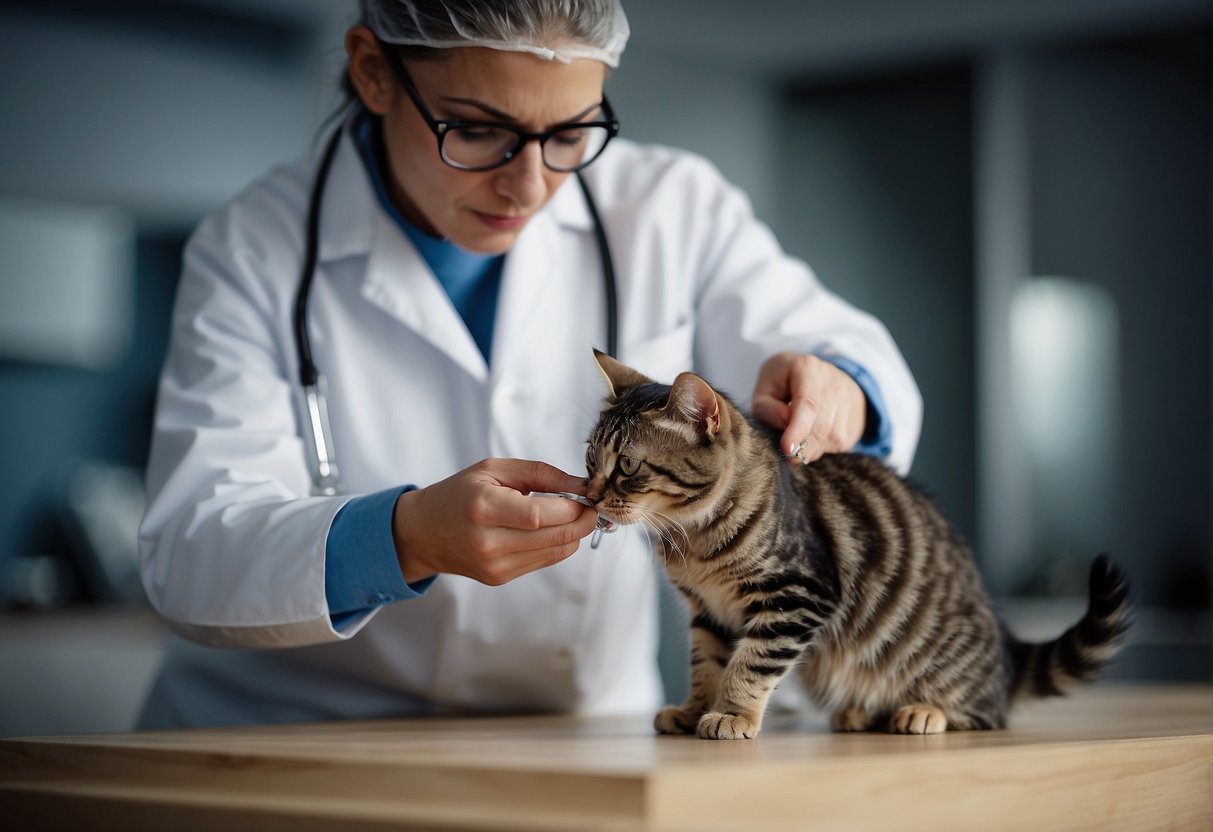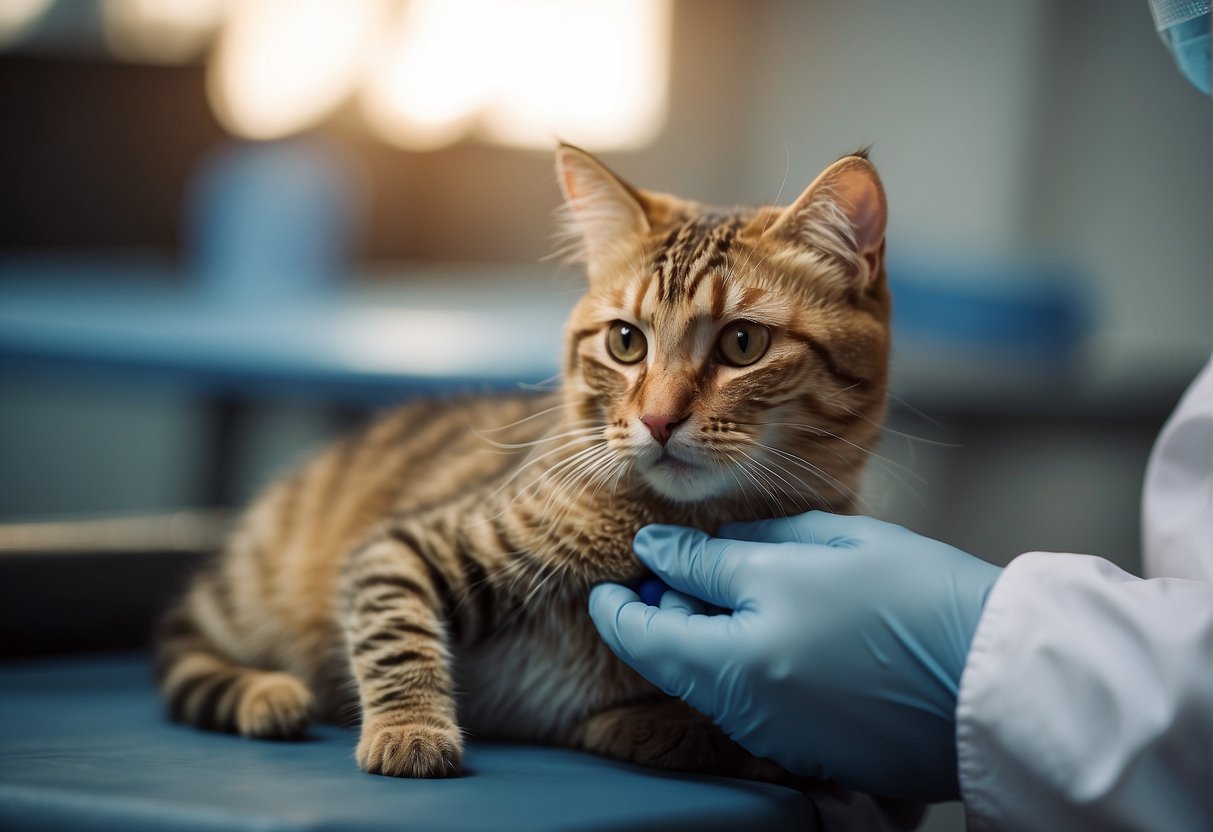When your cat needs a blood test, veterinarians typically draw blood from two main sites: the jugular vein in the neck or the saphenous or femoral vein in the back leg.
While taking a blood sample from the jugular might sound daunting, it’s actually a quick method that allows vets to collect a good-sized sample while keeping the procedure as smooth as possible for your feline friend.

Cats, much like us, can be quite sensitive to stress, so it’s crucial for veterinarians to use a gentle approach to minimize discomfort. This might mean swaddling your kitty in a towel to keep them calm, or it could entail waiting for your cat to settle down before proceeding with the sample collection.
The choice of the vein and the technique often depends on the cat’s temperament and physical condition.
Preparing for the Blood Draw

Taking your cat for bloodwork requires understanding their behavior and choosing the right vein for sampling. This preparation helps to ensure a smooth and stress-free experience.
Understanding Cat Behavior
Cats can often sense when they’re about to undergo something unpleasant and may become stressed or anxious. It’s important for you to keep calm, as cats can pick up on your emotions.
Familiarize your feline friend with their carrier and the car to reduce stress on the day of the blood draw. Practice by rewarding calm behavior and gentle handling at home to make the actual event less daunting for them.
Selecting the Appropriate Vein
Vets commonly use three veins for blood draws in cats:
- Jugular vein: Located in the neck, allowing for larger sample collection. This may require your cat to lie on their back or side, so it’s essential they are comfortable with this position beforehand.
- Cephalic vein: Found in the foreleg, suitable for small samples. Training your cat to stay still while their paw is held can be beneficial.
- Saphenous vein: Located on the hind leg, another option for smaller samples. Preparing your cat for restraint in this area can help prevent stress.
Blood Collection Techniques
When your feline friend needs to have their blood tested, veterinarians use specific techniques to make the process as stress-free as possible. They draw blood samples proficiently to ensure both the safety of the cat and the success of the test.
Venipuncture Procedure
To collect a blood sample from your cat, vets typically perform a venipuncture. This procedure involves puncturing a vein with a needle to withdraw blood. The jugular vein in the neck is often used because it’s large and provides a good flow of blood, but it requires your cat to be calm and still.
Alternatively, vets might use a leg vein, specifically the medial saphenous vein on the inside of the back leg, but this is generally more suitable for smaller blood samples. Here’s what to expect:
- Preparation: Your cat will be gently restrained, and the area of puncture will be cleaned and possibly shaved.
- Vein Access: The vet palpates the vein to determine the best entry point.
- Needle Insertion: They then swiftly insert the needle into the vein at the correct angle.
- Blood Withdrawal: A small amount of blood is drawn into the attached syringe.
- Post-Procedure: Pressure is applied to the puncture site to stop any bleeding.
Handling the Needle and Syringe
When drawing blood, the handling of the needle and syringe is crucial for both the collection success and your cat’s comfort. The vet uses a sterile needle, which is thin enough to minimize discomfort but wide enough to prevent the delicate blood cells from being destroyed.
Here are some key steps in needle and syringe handling:
- Needle Size: Typically, a 22-25 gauge needle is selected based on your cat’s size and the required blood sample volume.
- Syringe Preparation: The syringe is prepared beforehand, ensuring it’s free from air that could interfere with the sample.
- Smooth Technique: The vet uses a steady hand to introduce the needle, minimizing any jerky movements that could startle your cat.
Is Drawing Blood Painful For Cats?
When your cat needs a blood test, it’s natural to worry about their comfort and the pain they might experience. Vets have developed techniques to minimize discomfort and stress.
How Do Vets Make Cats Comfortable For This Procedure
Your vet knows that a visit can be stressful for your feline friend. To ensure your cat’s comfort during a blood draw:
- Preparation: They’ll likely start with some gentle petting to calm your cat.
- Restraint: A skilled veterinary technician will hold your cat in a comfortable position that’s safe for both the cat and the vet.
- Technique: Vets often use the smallest needle possible to reduce the sensation of the prick.
- Speed: The more experienced the vet, the quicker the procedure usually is, lessening the time your cat feels any discomfort.
During the blood draw, the vet may distract your cat with soothing sounds or a favorite treat. Remember, cats are good at hiding discomfort, so a calm exterior doesn’t always signal a pain-free experience, but your vet’s efforts can greatly reduce any pain.
How Long Does It Take To Draw The Blood From Your Cat
- Setup: The preparation takes a few minutes, ensuring everything is in place for an efficient draw.
- Actual Draw: Normally, the blood collection itself is very quick and takes just a few seconds to a minute, depending on the amount needed and how cooperative your cat is being.
Veterinary staff are trained to obtain the necessary samples swiftly to minimize the duration your cat has to endure the procedure. A smooth and swift blood draw hinges on both your cat’s temperament and the vet’s skill, with the aim of causing the least stress possible.

My name is James, and welcome to FAQCats!
Along with our team of cat owners, expert pet enthusiasts, and pet professionals, we aim to write engaging helpful, engaging content about cats. At FAQCats we strive to provide content that’s accurate and fun to read. Our team writes about everything related to cats; even the most complex of topics. Through extensive research and caring for our own fur-pals, we’re able to provide something cat owners worldwide will love. Have a look around, and leave us feedback anytime!

